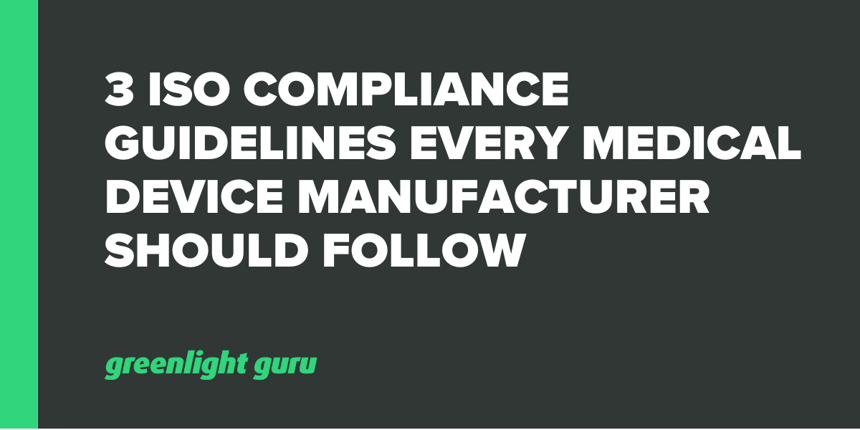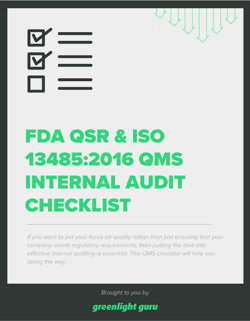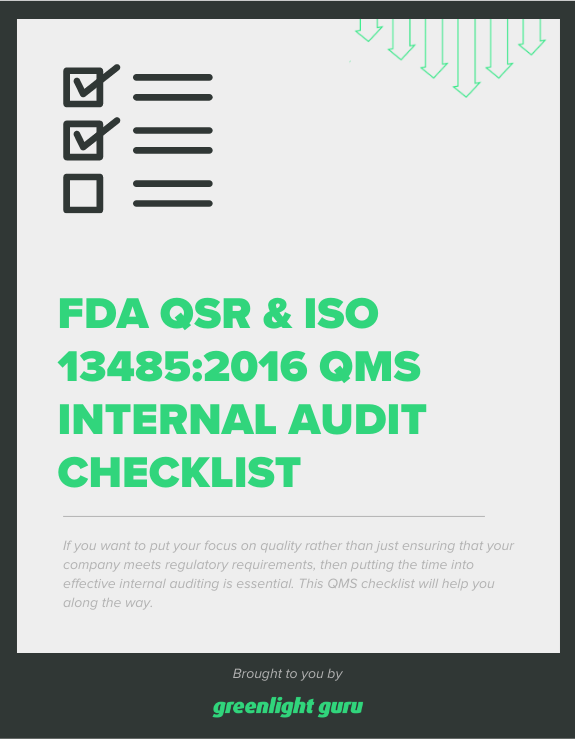3 ISO Compliance Guidelines Every Medical Device Manufacturer Should Follow

The word “compliance” can sound like a chore, or some sort of box to check before punching out at 5:00. However, in the medical device industry, compliance is more than a task; it’s an opportunity to be the best.
Though compliance with ISO (International Organization for Standardization) guidelines is not always a legal or regulatory requirement, these standards serve as blueprints for achieving excellence in the medical device industry.
Today, we’ll be focusing on three of the most well-known ISO standards for medical device manufacturers - ISO 13485, ISO 14971, and ISO 15223 - and what guidelines they can provide medical device companies in the pursuit of quality and excellence.
FREE DOWNLOAD: Click here to download your free PDF copy of our FDA QSR & ISO 13485:2016 Internal QMS Audit Checklist.
ISO 13485 compliance: quality happens by design
ISO has published several standards specific to medical devices, the first of which we’ll cover is ISO 13485:2016 for medical device quality management systems.
With this standard, ISO compliance is essential for medical device manufacturers, especially those looking to market products in the European Union (EU). Under EU Medical Device Regulation (EU MDR), an ISO 13485 certificate is often required for obtaining CE marking, which allows for device sale in the EU.
But ISO 13485 compliance is much more than following a to-do list. This standard is an extensive and top-to-bottom blueprint for not just implementing a quality management system, but building your entire manufacturing and design processes around it.
One of the most important elements of ISO 13485 is the presence of a quality manual and documentation. A quality manual helps to ensure that every change made to a product, every update, every audit, or product conformity assessment, is connected through end-to-end traceability.
Keeping these elements in check and staying compliant with ISO 13485 will be of huge help, especially when considering the final piece of the ISO compliance puzzle for medical devices: risk mitigation.
ISO 14971 compliance: approach risk proactively, not reactively
ISO 14971 is a ten-section standard which establishes guidance for risk analysis, evaluation, control and management. It also outlines specific procedures for auditing and monitoring throughout the entire product lifecycle, including production and post-production.
The requirements of ISO 14971 are harmonized with the EU Medical Devices Regulation in the EU. Furthermore, just about any regulatory standard you can find in the world, including that of FDA in the US, will require a risk management system.
The basis of risk mitigation strategy is twofold; the first is to establish a system that allows manufacturers to react swiftly, appropriately, and efficiently in the event of an incident. The second - though perhaps still a continuation of the first - is to set up systems which will prevent such an act from happening again.
Much like design controls and your QMS documentation, a risk mitigation strategy should be built alongside your product design and review process. Be sure to sync up your design validation and risk management reporting; one good test of this is to write the risk management report, showing that you've assessed the risks associated with your medical device and found that the medical benefits outweigh the risks associated with your device.
Once you release your product to market, production and post-production risk management will become the focus of your risk management activities. Customer complaints and feedback, your CAPA process, internal audits, QA processes, and other aspects of your overall QMS all feed into risk management. Because of this, you should continuously revise your risk management report to reflect new risks that you learn about through these avenues.
ISO 15223 compliance: a symbol says a thousand words about safe use
Updated most recently in 2021, ISO 15223 is a standard covering the use of symbols to communicate information to be supplied by the manufacturer.
To ensure medical devices are used safely, manufacturers are required to print relevant information on the device itself, its labeling materials, or in what’s called accompanying information. These critical instructions and warnings cover the installation, use, processing, maintenance, decommissioning, and disposal of a medical device.
The wide range of messaging found in ISO 15223, as well as the complex technical nature of such instructions, requires crystal-clear communication, regardless of whether they’re operated by seasoned care providers or non-medical professionals.
To keep things concise, manufacturers are permitted to use graphics and symbols to indicate characteristics users need to know about. For one, this allows manufacturers to convey a great deal of operational and safety information in a condensed space. It also reduces the need for the supplier or receiver of the information to have knowledge of the language of a particular geographic location or demographic.
Of course, the effectiveness of symbols relies on a universally adopted set of standards for consistency. ISO 15223 does a thorough job of locking in the exact requirements for the symbols’ characteristics, definitions, and placements on or around the device.
Currently in its fourth edition, manufacturers can leverage ISO 15223-1:2021 to greatly expand the potential reach of their device to patients across the globe.
FREE DOWNLOAD: Click here to download your free PDF copy of our FDA QSR & ISO 13485:2016 Internal QMS Audit Checklist.
ISO compliance is made easy with Greenlight Guru
Staying ISO compliant certainly requires a lot of organization and interconnectivity. One of the most important factors in achieving and maintaining compliance is the systems in which you use.
Don’t make the mistake of using legacy or generic systems that aren’t purpose-built for the medical device industry, as these are commonly known to cause major issues and result in noncompliance.
By choosing the right medical device-specific solution, like Greenlight Guru’s MedTech Lifecycle Excellence Platform, you can guarantee end-to-end traceability, full visibility and connectivity of all documentation and processes, and built-in support mechanisms to help you follow ISO compliance best practices.
Ready to get started? Contact us today for your free demo!
Etienne Nichols is the Head of Industry Insights & Education at Greenlight Guru. As a Mechanical Engineer and Medical Device Guru, he specializes in simplifying complex ideas, teaching system integration, and connecting industry leaders. While hosting the Global Medical Device Podcast, Etienne has led over 200...
Related Posts
ISO 13485: Ultimate Guide to Medical Devices QMS
ISO 14971 Risk Management for Medical Devices: The Definitive Guide
25 FAQs (& Answers) about ISO 15223-1:2021 Fourth Edition
Get your free PDF
FDA QSR & ISO 13485:2016 Internal Audit Checklist











